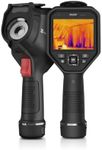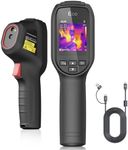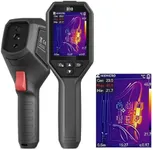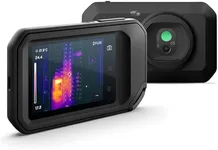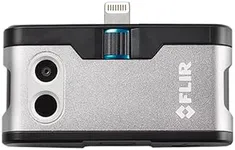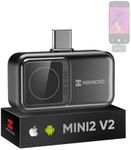Buying Guide for the Best Thermal Cameras
When choosing a thermal camera, it's important to understand that these devices are used to detect heat and create images based on temperature differences. They are widely used in various fields such as building inspections, electrical maintenance, and even wildlife observation. The key to selecting the right thermal camera is to consider the specific needs of your application, as different models offer varying features and capabilities. Understanding the key specifications will help you make an informed decision that best suits your requirements.ResolutionResolution in thermal cameras refers to the number of pixels in the thermal image. A higher resolution means more pixels, which results in a clearer and more detailed image. This is important because it allows you to see finer details and detect smaller temperature differences. Resolutions can range from low (80x60 pixels) to high (640x480 pixels or more). If you need to inspect small components or require detailed images, opt for a higher resolution. For general use or larger targets, a lower resolution may suffice.
Thermal Sensitivity (NETD)Thermal sensitivity, also known as Noise Equivalent Temperature Difference (NETD), measures the smallest temperature difference a camera can detect. It is expressed in millikelvins (mK). A lower NETD value indicates higher sensitivity, meaning the camera can detect smaller temperature differences. This is crucial for applications requiring precise temperature measurements, such as electrical inspections or research. If your work involves detecting subtle temperature changes, choose a camera with a lower NETD. For less demanding tasks, a higher NETD might be adequate.
Temperature RangeThe temperature range of a thermal camera indicates the minimum and maximum temperatures it can accurately measure. This is important because it determines the suitability of the camera for different environments and applications. Temperature ranges can vary widely, from -20°C to 150°C for basic models, up to 2000°C or more for advanced models. Consider the typical temperature range of your application. For example, if you're inspecting industrial equipment, you might need a camera with a higher maximum temperature range.
Field of View (FOV)Field of View (FOV) refers to the extent of the observable area the camera can capture at any given moment. A wider FOV allows you to see more of the scene, which is useful for scanning large areas quickly. Conversely, a narrower FOV provides more detail on a smaller area, which is beneficial for close-up inspections. Choose a FOV based on your typical use case: a wide FOV for large area surveys or a narrow FOV for detailed inspections of specific components.
Image FrequencyImage frequency, or refresh rate, is the number of times per second the camera updates the thermal image. It is measured in hertz (Hz). A higher refresh rate provides smoother motion and is important for capturing fast-moving objects or for applications where real-time analysis is critical. Common refresh rates are 9Hz, 30Hz, and 60Hz. If your work involves dynamic scenes or moving targets, opt for a higher refresh rate. For static inspections, a lower refresh rate may be sufficient.
Display and ConnectivityThe display and connectivity options of a thermal camera determine how you view and share the thermal images. Some cameras have built-in displays, while others connect to external devices like smartphones or tablets. Connectivity options may include Wi-Fi, Bluetooth, or USB. Consider how you plan to use the camera: if you need to share images quickly or work in the field, look for models with robust connectivity features. If you prefer analyzing images on a larger screen, ensure the camera can easily connect to your preferred device.
